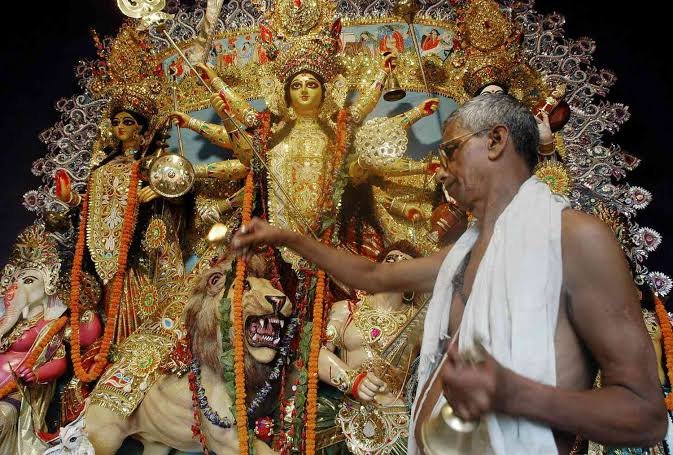Durga Puja in Bengal: A Tapestry of Divine Splendor, Cultural Eminence, and Historical Resonance


আশ্বিনের শারদপ্রাতে বেজে উঠেছে আলোক মঞ্জীর;ধ
রণীর বহিরাকাশে অন্তরিত মেঘমালা;
প্রকৃতির অন্তরাকাশে জাগরিত জ্যোতির্ময়ী জগন্মাতার আগমন বার্তা।
In the autumnal embrace of Ashwin, there arises a resplendent beacon of light;
The outer firmament of the Earth is adorned with a diaphanous mantle of cloud;
In the celestial expanse of nature, the awakened luminous deity, the universal mother, imparts her message of arrival.
Bharat, a land steeped in festivities, finds its apex in Bengal, where the oft-heard refrain resonates: ‘Baro Maash, Tero Parbon’—a testament to thirteen festivals observed in the span of twelve months. Amongst these, the paramount celebration is that of Durga Puja, aligning harmoniously with the festive spirit that pervades the heart of Bharat.
A festival of profound religious significance, Durga Puja stands as an ode to the cultural vitality and spiritual fervor of Bengal. Rooted in the venerable annals of Hindu scriptures, it venerates Goddess Durga, the quintessence of feminine divinity, commemorating her triumphant vanquishing of the malevolent demon, Mahishasura.
Enshrined in the sacred “Markandeya Purana,” the legend resonates with Mahishasura’s malevolence and Durga’s celestial intervention. This tale, steeped in profound symbolism, exalts the victory of virtue over vice, an eternal parable of righteousness overcoming maleficence.
The embrace of Durga Puja in Bengal finds its genesis in this celestial saga, transcending the mere contours of a cosmic clash. It embodies an allegory of the perpetual struggle between luminosity and obscurity, good and malevolence, with resonant moral and spiritual connotations.
The medieval epoch in Bengal, heralded a flourishing of unique cultural heritage, unsullied by imperial influence. Here, Durga Puja found fertile soil, nurtured by the ardent hearts and creative souls of the Bengali populace.
In this cultural renaissance, figures like Chaitanya Mahaprabhu and the valiant Pratapaditya, ruler of Jessore, championed devotion to the divine feminine. Their teachings infused the festival with heightened spiritual fervor, elevating it from a mere annual ritual to a profound, communal odyssey.
The 18th and 19th centuries marked a renaissance in Bengal, untouched by the vestiges of imperial dominion. Zamindars, the feudal custodians of Bengal, undertook the mantle of nurturing art, culture, and religious traditions. Durga Puja, once a family affair, blossomed into a grand public spectacle, bedecked with opulent embellishments, extravagant banquets, and artistic splendors. This benevolent patronage solidified its status as an indelible cornerstone of Bengali culture.
The inception of “barowari,” a collaborative endeavor where twelve companions jointly orchestrate the puja, exemplifies this period of democratization. It heralded a more inclusive and vibrant celebration, involving the wider community.
In the 19th century, luminaries of the Bengal Renaissance, such as Ishwar Chandra Vidyasagar, discerned the profound cultural and societal import of Durga Puja. They ardently advocated for its observance, recognizing it as an integral facet of Bengali identity. The clarion call of the swadeshi movement, advocating self-reliance and cultural autonomy, further imbued the festival with the fervor of nationalism.
Today, Durga Puja transcends religious confines, evolving into a grand cultural extravaganza, celebrated with unrivaled ardor. It has evolved from modest bamboo and thatch structures into resplendent pandals, each year pushing the boundaries of artistic expression. These pandals, often imbued with socio-political motifs, serve as canvases for cultural commentary, mirroring contemporary issues and aspirations.
In summation, Durga Puja in Bengal transcends being a mere religious observance; it is an affirmation of cultural identity, a reflection of artistic genius, and a testament to the enduring vitality of Bengal. Rooted in ancient Hindu scriptures, nurtured through centuries of devotion, and enriched by the intellectual and artistic blossoming of the Renaissance, it stands as a living testament to the vibrant tapestry of Bengal’s cultural heritage.
DISCLAIMER: The author is solely responsible for the views expressed in this article. The author carries the responsibility for citing and/or licensing of images utilized within the text.
